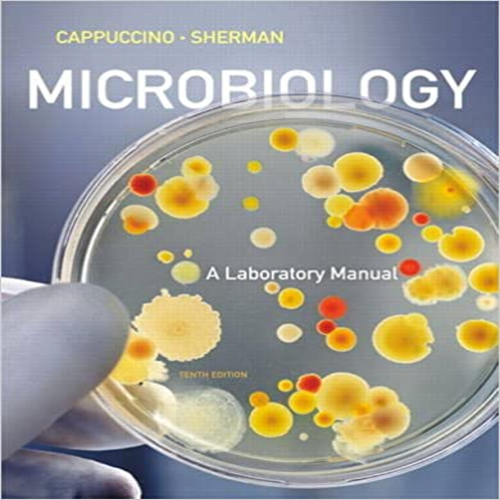Solution Manual for Microbiology A Laboratory Manual 10th Edition Cappuccino Sherman 0321840224 9780321840226
$35.00 Original price was: $35.00.$26.50Current price is: $26.50.
Click Icon bellow to Download sample Solution Manual for Microbiology A Laboratory Manual 10th Edition Cappuccino Sherman 0321840224 9780321840226:
This is completed downloadable of Microbiology A Laboratory Manual 10th Edition by James G. Cappuccino and Natalie Sherman Solution Manual.

Instant download Microbiology A Laboratory Manual 10th Edition by James G. Cappuccino and Natalie Sherman Solution Manual pdf docx epub after payment.
Product Details:
Versatile, comprehensive, and clearly written, this competitively priced laboratory manual can be used with any undergraduate microbiology text—and now features brief clinical applications for each experiment, and a new experiment on hand washing. Microbiology: A Laboratory Manual is known for its thorough coverage, descriptive and straightforward procedures, and minimal equipment requirements. A broad range of experiments helps to convey basic principles and techniques. Each experiment includes an overview, an in-depth discussion of the principle involved, easy-to-follow procedures, and lab reports with review and critical thinking questions. Ample introductory material and laboratory safety instructions are provided.
Language: English
ISBN-10: 0321840224
ISBN-13: 978-0321840226
ISBN-13: 9780321840226
Author: James G. Cappuccino and Natalie Sherman
microbiology a laboratory manual 10th edition pdf
microbiology a laboratory manual 10th edition solution pdf free
microbiology lab manual cappuccino 10th edition pdf
microbiology a laboratory manual 10th edition pdf free download
microbiology laboratory manual 10th edition pdf free
Table of Content:
Part 1: Basic Laboratory Techniques for Isolation, Cultivation, and Cultural Characterization of Microorganisms
1. Effectiveness of Hand Washing
2. Culture Transfer Techniques
3. Techniques for Isolation of Pure Cultures
4. Cultural Characteristics of Microorganisms
Part 2: Microscopy
5. Microscopic Examination of Stained Cell Preparations
6. Microscopic Examination of Living Microorganisms Using a Hanging-Drop Preparation or a Wet Mount
7. The Microscopic Measurement of Microorganisms
Part 3: Bacterial Staining
8. Preparation of Bacterial Smears
9. Simple Staining
10. Negative Staining
11. Gram Stain
12. Acid-Fast Stain
13. Differential Staining for Visualization of Bacterial Cell Structures
Part 4: Cultivation of Microorganisms: Nutritional and Physical Requirements, and Enumeration of Microbial Poulations
14. Nutritional Requirements: Media for the Routine Cultivation of Bacteria
15. Use of Differential, Selective, and Enriched Media
16. Physical Factors: Temperature
17. Physical Factors: pH of the Extracellular Environment
18. Physical Factors: Atmospheric Oxygen Requirements
19. Techniques for the Cultivation of Anaerobic Microorganisms
20. Serial Dilution – Agar Plate Procedure to Quantitate Viable Cells
21. The Bacterial Growth Curve
Part 5: Biochemical Activities of Microorganisms
22. Extracellular Enzymatic Activities of Microorganisms
23. Carbohydrate Fermentation
24. Triple Sugar-Iron Agar Test
25. IMViC Test
26. Hydrogen Sulfide Test
27. Urease Test
28. Litmus Milk Reactions
29. Nitrate Reduction Test
30. Catalase Test
31. Oxidase Test
32. Utilization of Amino Acids
33. Genus Identification of Unknown Bacterial Cultures
Part 6: The Protozoa
34. Free-Living Protozoa
35. Parasitic Protozoa
Part 7: The Fungi
36. Cultivation and Morphology of Molds
37. Yeast Morphology, Cultural Characteristics, and Reproduction
38. Identification of Unknown Fungi
Part 8: The Viruses
39. Cultivation and Enumeration of Bacteriophages
40. Isolation of Coliphages from Raw Sewage
Part 9: Physical and Chemical Agents for the Control of Microbial Growth
41. Physical Agents of Control: Moist Heat
42. Physical Agents of Control: Environmental Osmotic Pressure
43. Physical Agents of Control: Electromagnetic Radiations
44. Chemical Agents of Control: Chemotherapeutic Agents
45. Determination of Penicillin Activity in the Presence and Absence of Penicillinase
46. Chemical Agents of Control: Disinfectants and Antiseptics
Part 10: Microbiology of Food
47. Microbiological Analysis of Food Products: Bacterial Count
48. Wine Production
Part 11: Microbiology of Water
49. Standard Qualitative Analysis of Water
50. Quantitative Analysis of Water: Membrane Filter Method
Part 12: Microbiology of Soil
51. Microbial Populations in Soil: Enumeration
52. Isolation of Antibiotic-Producing Microorganisms and Determination of Antimicrobial Spectrum of Isolates
53. Isolation of Pseudomonas Species by Means of the Enrichment Culture Technique
Part 13: Bacterial Genetics
53. Enzyme Induction
54. Bacterial Conjugation
55. Isolation of a Streptomycin-Resistant Mutant
56. The Ames Test: A Bacterial Test System for Chemical Carcinogenicity
Part 14: Biotechnology
57. Bacterial Transformation
58. Isolation of Bacterial Plasmids
59. Restriction Analysis and Electrophoretic Separation of Bacteriophage Lambda DNA
Part 15: Medical Microbiology
60. Microbial Flora of the Mouth: Determination of Susceptibility to Dental Caries
61. Normal Microbial Flora of the Throat and Skin
62. Identification of Human Staphylococcal Pathogens
63. Identification of Human Streptococcal Pathogens
64. Identification of Streptococcus pneumoniae
65. Identification of Enteric Microorganisms Using Computer-Assisted Multitest Microsystems
66. Isolation and Presumptive Identification of Campylobacter
67. Microbiological Analysis of Urine Specimens
68. Microbiological Analysis of Blood Specimens
69. Species Identification of Unknown Bacterial Cultures
Part 16: Immunology
70. Precipitin Reaction: The Ring Test
71. Agglutination Reaction: The Febrile Antibody
72. Immunofluorescence
73. Enzyme-Linked Immunoabsorbent Assay
74. Agglutination Reaction: Mono-Test for Infectious Mononucleosis
75. Sexually Transmitted Diseases: Rapid Immunodiagnostic Procedures
People Also Search:
microbiology a laboratory manual 10th edition pdf free
microbiology a laboratory manual 10th edition solution pdf
microbiology lab manual 10th edition pdf
microbiology laboratory manual 10th answers
microbiology lab manual 10th answers





